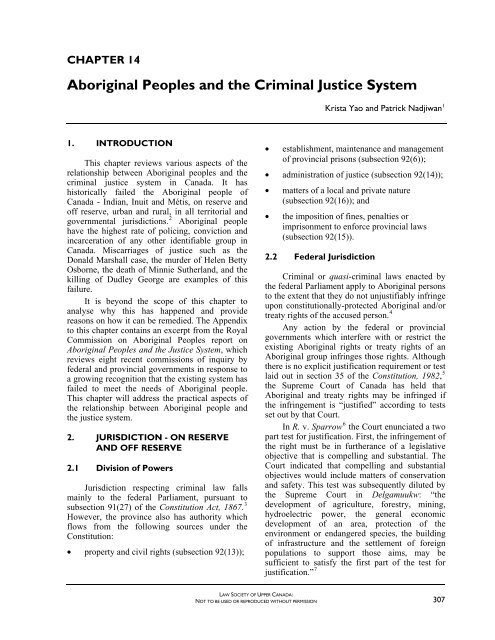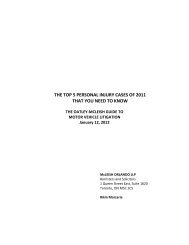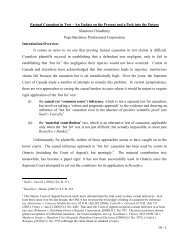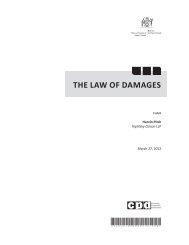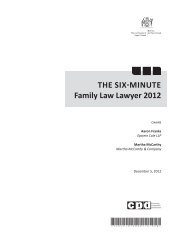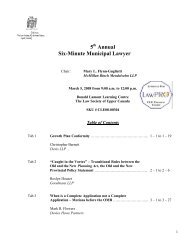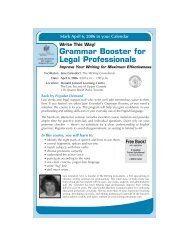Aboriginal Peoples and the Criminal Justice System - Continuing ...
Aboriginal Peoples and the Criminal Justice System - Continuing ...
Aboriginal Peoples and the Criminal Justice System - Continuing ...
Create successful ePaper yourself
Turn your PDF publications into a flip-book with our unique Google optimized e-Paper software.
CHAPTER 14<br />
<strong>Aboriginal</strong> <strong>Peoples</strong> <strong>and</strong> <strong>the</strong> <strong>Criminal</strong> <strong>Justice</strong> <strong>System</strong><br />
1. INTRODUCTION<br />
This chapter reviews various aspects of <strong>the</strong><br />
relationship between <strong>Aboriginal</strong> peoples <strong>and</strong> <strong>the</strong><br />
criminal justice system in Canada. It has<br />
historically failed <strong>the</strong> <strong>Aboriginal</strong> people of<br />
Canada - Indian, Inuit <strong>and</strong> Métis, on reserve <strong>and</strong><br />
off reserve, urban <strong>and</strong> rural, in all territorial <strong>and</strong><br />
governmental jurisdictions. 2 <strong>Aboriginal</strong> people<br />
have <strong>the</strong> highest rate of policing, conviction <strong>and</strong><br />
incarceration of any o<strong>the</strong>r identifiable group in<br />
Canada. Miscarriages of justice such as <strong>the</strong><br />
Donald Marshall case, <strong>the</strong> murder of Helen Betty<br />
Osborne, <strong>the</strong> death of Minnie Su<strong>the</strong>rl<strong>and</strong>, <strong>and</strong> <strong>the</strong><br />
killing of Dudley George are examples of this<br />
failure.<br />
It is beyond <strong>the</strong> scope of this chapter to<br />
analyse why this has happened <strong>and</strong> provide<br />
reasons on how it can be remedied. The Appendix<br />
to this chapter contains an excerpt from <strong>the</strong> Royal<br />
Commission on <strong>Aboriginal</strong> <strong>Peoples</strong> report on<br />
<strong>Aboriginal</strong> <strong>Peoples</strong> <strong>and</strong> <strong>the</strong> <strong>Justice</strong> <strong>System</strong>, which<br />
reviews eight recent commissions of inquiry by<br />
federal <strong>and</strong> provincial governments in response to<br />
a growing recognition that <strong>the</strong> existing system has<br />
failed to meet <strong>the</strong> needs of <strong>Aboriginal</strong> people.<br />
This chapter will address <strong>the</strong> practical aspects of<br />
<strong>the</strong> relationship between <strong>Aboriginal</strong> people <strong>and</strong><br />
<strong>the</strong> justice system.<br />
2. JURISDICTION - ON RESERVE<br />
AND OFF RESERVE<br />
2.1 Division of Powers<br />
Jurisdiction respecting criminal law falls<br />
mainly to <strong>the</strong> federal Parliament, pursuant to<br />
subsection 91(27) of <strong>the</strong> Constitution Act, 1867. 3<br />
However, <strong>the</strong> province also has authority which<br />
flows from <strong>the</strong> following sources under <strong>the</strong><br />
Constitution:<br />
• property <strong>and</strong> civil rights (subsection 92(13));<br />
LAW SOCIETY OF UPPER CANADA:<br />
NOT TO BE USED OR REPRODUCED WITHOUT PERMISSION<br />
Krista Yao <strong>and</strong> Patrick Nadjiwan 1<br />
• establishment, maintenance <strong>and</strong> management<br />
of provincial prisons (subsection 92(6));<br />
• administration of justice (subsection 92(14));<br />
• matters of a local <strong>and</strong> private nature<br />
(subsection 92(16)); <strong>and</strong><br />
• <strong>the</strong> imposition of fines, penalties or<br />
imprisonment to enforce provincial laws<br />
(subsection 92(15)).<br />
2.2 Federal Jurisdiction<br />
<strong>Criminal</strong> or quasi-criminal laws enacted by<br />
<strong>the</strong> federal Parliament apply to <strong>Aboriginal</strong> persons<br />
to <strong>the</strong> extent that <strong>the</strong>y do not unjustifiably infringe<br />
upon constitutionally-protected <strong>Aboriginal</strong> <strong>and</strong>/or<br />
treaty rights of <strong>the</strong> accused person. 4<br />
Any action by <strong>the</strong> federal or provincial<br />
governments which interfere with or restrict <strong>the</strong><br />
existing <strong>Aboriginal</strong> rights or treaty rights of an<br />
<strong>Aboriginal</strong> group infringes those rights. Although<br />
<strong>the</strong>re is no explicit justification requirement or test<br />
laid out in section 35 of <strong>the</strong> Constitution, 1982, 5<br />
<strong>the</strong> Supreme Court of Canada has held that<br />
<strong>Aboriginal</strong> <strong>and</strong> treaty rights may be infringed if<br />
<strong>the</strong> infringement is “justified” according to tests<br />
set out by that Court.<br />
In R. v. Sparrow 6 <strong>the</strong> Court enunciated a two<br />
part test for justification. First, <strong>the</strong> infringement of<br />
<strong>the</strong> right must be in fur<strong>the</strong>rance of a legislative<br />
objective that is compelling <strong>and</strong> substantial. The<br />
Court indicated that compelling <strong>and</strong> substantial<br />
objectives would include matters of conservation<br />
<strong>and</strong> safety. This test was subsequently diluted by<br />
<strong>the</strong> Supreme Court in Delgamuukw: “<strong>the</strong><br />
development of agriculture, forestry, mining,<br />
hydroelectric power, <strong>the</strong> general economic<br />
development of an area, protection of <strong>the</strong><br />
environment or endangered species, <strong>the</strong> building<br />
of infrastructure <strong>and</strong> <strong>the</strong> settlement of foreign<br />
populations to support those aims, may be<br />
sufficient to satisfy <strong>the</strong> first part of <strong>the</strong> test for<br />
justification.” 7<br />
307
CH - 14 CRIMINAL LAW BAC - 2005<br />
The second part of <strong>the</strong> test requires an<br />
assessment of whe<strong>the</strong>r <strong>the</strong> infringement is<br />
consistent with <strong>the</strong> special fiduciary relationship<br />
between <strong>the</strong> Crown <strong>and</strong> <strong>Aboriginal</strong> peoples. The<br />
<strong>the</strong>ory behind this principle is that <strong>the</strong> fiduciary<br />
relationship requires <strong>Aboriginal</strong> interests be<br />
considered first, although <strong>the</strong>y need not always be<br />
given priority. The primacy of <strong>the</strong> fiduciary duty<br />
is a function of <strong>the</strong> nature of <strong>the</strong> <strong>Aboriginal</strong> right<br />
at issue. For example, <strong>Aboriginal</strong> food fisheries<br />
were given priority after valid conservation<br />
measures. 8 However, where <strong>the</strong> <strong>Aboriginal</strong> right<br />
was to sell fish commercially, that right was<br />
“constitutionally satisfied if <strong>the</strong> government had<br />
taken those rights into account <strong>and</strong> has allocated a<br />
resource ‘in a manner respectful’ of [<strong>the</strong><br />
<strong>Aboriginal</strong>] priority.” 9<br />
2.3 Provincial Jurisdiction<br />
Provincial laws apply to <strong>Aboriginal</strong> persons<br />
in two ways. 10 First, provincial laws apply<br />
directly to Indians of <strong>the</strong>ir own force (ex proprio<br />
vigore) as long as <strong>the</strong> laws do not invade<br />
exclusive federal authority over Indians <strong>and</strong> l<strong>and</strong>s<br />
reserved for Indians, or are inconsistent with<br />
federal law. Therefore, laws such as highway<br />
traffic legislation, business licensing <strong>and</strong><br />
regulation, <strong>and</strong> environmental regulations<br />
normally apply. The major limitation to provincial<br />
jurisdiction is that a provincial law can not affect<br />
“Indianness” or derogate from <strong>the</strong> “status <strong>and</strong><br />
capacities” of Indians, <strong>and</strong> may not affect Indian<br />
reserve l<strong>and</strong>s or <strong>Aboriginal</strong> or treaty rights.<br />
Second, provincial laws apply to Indians by<br />
operation of section 88 of <strong>the</strong> Indian Act: 11<br />
88. Subject to <strong>the</strong> terms of any treaty <strong>and</strong><br />
any o<strong>the</strong>r Act of <strong>the</strong> Parliament, all laws of<br />
general application from time to time in<br />
force in any province are applicable to <strong>and</strong><br />
in respect of Indians in <strong>the</strong> province, except<br />
to <strong>the</strong> extent that those laws are inconsistent<br />
with this Act or any order, rule, regulation or<br />
by-law made <strong>the</strong>reunder, <strong>and</strong> except to <strong>the</strong><br />
extent that those laws make provision for<br />
any matter for which provision is made by<br />
or under this Act.<br />
Section 88 of <strong>the</strong> Indian Act operates to<br />
incorporate into federal law those provincial laws<br />
of general application which do invade exclusive<br />
federal authority. 12 The operation of <strong>the</strong><br />
incorporated provincial statute is, however,<br />
subject to treaties <strong>and</strong> federal laws, <strong>and</strong> is only<br />
308<br />
LAW SOCIETY OF UPPER CANADA:<br />
NOT TO BE USED OR REPRODUCED WITHOUT PERMISSION<br />
applicable to <strong>the</strong> extent that such laws are not<br />
inconsistent with <strong>the</strong> Indian Act, or any order,<br />
rule, regulation or b<strong>and</strong> by-law made under <strong>the</strong><br />
Indian Act.<br />
Subsection 35(1) of <strong>the</strong> Constitution Act,<br />
1982 still applies to provincial laws which might<br />
be referentially incorporated as a result of section<br />
88. In o<strong>the</strong>r words, even if such a law is found to<br />
apply to Indians as a result of section 88, it must<br />
still not unjustifiably infringe <strong>Aboriginal</strong> or treaty<br />
rights. The province must comply with <strong>the</strong> same<br />
tests as <strong>the</strong> federal Crown to justify infringement<br />
of rights. Moreover, although <strong>the</strong> Federal<br />
government had <strong>the</strong> capacity to extinguish<br />
<strong>Aboriginal</strong> <strong>and</strong> treaty rights in certain<br />
circumstances prior to 1982, provincial<br />
governments have never had jurisdiction to do so.<br />
Since <strong>Aboriginal</strong> <strong>and</strong> treaty rights go to <strong>the</strong> “core<br />
of Indianness”, it is not within <strong>the</strong> jurisdiction of<br />
<strong>the</strong> province to legislate in relation <strong>the</strong>reto. 13<br />
For example, provincial seizure legislation<br />
has been held to apply to Indians, except to <strong>the</strong><br />
extent that it calls upon seizure of property which<br />
is exempt according to section 89 of <strong>the</strong> Indian<br />
Act. 14 Some hunting <strong>and</strong> fishing legislation has<br />
been held to apply, except where it conflicts with<br />
<strong>the</strong> Indian Act, b<strong>and</strong> by-laws <strong>and</strong> <strong>Aboriginal</strong><br />
<strong>and</strong>/or treaty rights. 15 It is primarily portions of<br />
hunting <strong>and</strong> fishing legislation which have been<br />
held not to apply to Indians. 16<br />
3. ADVISING THE ABORIGINAL<br />
ACCUSED<br />
3.1 <strong>Aboriginal</strong> <strong>and</strong>/or Treaty Rights<br />
Because of <strong>the</strong> potential that criminal or<br />
quasi-criminal legislation may be inapplicable to<br />
an <strong>Aboriginal</strong> accused by reason of <strong>Aboriginal</strong><br />
<strong>and</strong>/or treaty rights, it is important for counsel to<br />
consider <strong>the</strong> nature of <strong>the</strong> charges <strong>and</strong> <strong>the</strong><br />
accused’s <strong>Aboriginal</strong> status. Protection of<br />
<strong>Aboriginal</strong> <strong>and</strong> treaty rights applies to Indians,<br />
Métis <strong>and</strong> Inuit, as defined in subsection 35(2).<br />
It should also be kept in mind, however, that<br />
in most cases, <strong>the</strong> cost of mounting a defence<br />
based upon <strong>Aboriginal</strong> <strong>and</strong> treaty rights is<br />
prohibitive for a single accused. A great deal of<br />
historical, geographical <strong>and</strong> genealogical research<br />
is needed in addition to <strong>the</strong> legal preparation <strong>and</strong><br />
knowledge required. This type of information will<br />
generally not be immediately available to <strong>the</strong><br />
accused, who may not even be aware of <strong>the</strong>
BAC - 2005 ABORIGINAL PEOPLES AND THE CRIMINAL JUSTICE SYSTEM CH - 14<br />
existence or extent of his or her <strong>Aboriginal</strong> <strong>and</strong>/or<br />
treaty rights.<br />
For this reason, it will generally be important<br />
for <strong>the</strong> accused to have <strong>the</strong> support of his or her<br />
First Nation or <strong>Aboriginal</strong> community, who may<br />
be in a position to provide necessary resources,<br />
both financial <strong>and</strong> historical (research) which are<br />
necessary to establish a defence based upon<br />
<strong>Aboriginal</strong> <strong>and</strong>/or treaty rights.<br />
Certain types of charges should lead counsel<br />
to consider whe<strong>the</strong>r <strong>the</strong>re may be a defence of<br />
existing <strong>Aboriginal</strong> <strong>and</strong>/or treaty rights. These<br />
include:<br />
• all hunting <strong>and</strong> fishing charges;<br />
• licensing charges;<br />
• hunting <strong>and</strong> fishing safety related charges; 17<br />
• trespass charges; <strong>and</strong><br />
• firearms charges. 18<br />
While <strong>the</strong> legal tests for Métis rights are<br />
somewhat similar to those for Indians, <strong>the</strong>re are<br />
some meaningful differences. Most notably,<br />
while Indians are required to show that an<br />
aboriginal right existed prior to European contact,<br />
that test is, by definition, not applicable to Métis<br />
rights. This changes a key date in a defendants<br />
case, <strong>and</strong> is something which must be considered<br />
early in <strong>the</strong> preparation of <strong>the</strong> defence. In 2003 <strong>the</strong><br />
Supreme Court of Canada had its first opportunity<br />
to address <strong>Aboriginal</strong> rights of <strong>the</strong> Métis. In R. v.<br />
Powley, <strong>the</strong> Court recognized that members of <strong>the</strong><br />
Métis community near Sault Ste. Marie have sitespecific<br />
<strong>Aboriginal</strong> hunting rights which were<br />
infringed, without justification, by Ontario’s<br />
hunting legislation. The Court said that <strong>the</strong><br />
relevant date was <strong>the</strong> date of effective European<br />
control; which, in <strong>the</strong> case of <strong>the</strong> Sault Ste. Marie<br />
Métis, was 1850. 19<br />
3.2 Jurisdictional Issues<br />
There will also be some cases where counsel<br />
must consider whe<strong>the</strong>r <strong>the</strong> province or Parliament,<br />
whatever <strong>the</strong> case may be, has jurisdiction to<br />
legislate in relation to <strong>the</strong> charges faced by <strong>the</strong><br />
<strong>Aboriginal</strong> accused, particularly where <strong>the</strong> charge<br />
was laid on reserve l<strong>and</strong>. If <strong>the</strong> charge is based<br />
upon a provincial statute or regulation, it must<br />
first be determined whe<strong>the</strong>r <strong>the</strong> province has<br />
jurisdiction to regulate <strong>the</strong> matter according to <strong>the</strong><br />
LAW SOCIETY OF UPPER CANADA:<br />
NOT TO BE USED OR REPRODUCED WITHOUT PERMISSION<br />
two ways that provincial laws can apply to<br />
Indians, as described above. 20 If <strong>the</strong>re is prima<br />
facie jurisdiction, <strong>the</strong> issue of paramountcy of<br />
legislation must be considered. For example, even<br />
if <strong>the</strong>re is jurisdiction for provincial legislation in<br />
a particular area, such legislation or regulation<br />
will not apply on a reserve if <strong>the</strong>re is concurrent<br />
legislation enacted by <strong>the</strong> Crown or through a<br />
First Nation law or by-law.<br />
Jurisdictional issues may arise for an<br />
accused, ei<strong>the</strong>r <strong>Aboriginal</strong> or non-<strong>Aboriginal</strong>, who<br />
has some sort of contact with or on an Indian<br />
reserve (<strong>and</strong> in some cases in <strong>the</strong> traditional<br />
territory of a First Nation). The following are<br />
examples of where jurisdictional issues may arise:<br />
• business regulation/licensing/fees/taxes;<br />
• trespass charges;<br />
• hunting <strong>and</strong> fishing violations; <strong>and</strong><br />
• highway traffic charges.<br />
The effect of subsection 89(1) of <strong>the</strong> Indian<br />
Act should also be noted for its practical<br />
application in criminal <strong>and</strong> quasi-criminal law<br />
matters, particularly in hunting <strong>and</strong> fishing related<br />
charges. Subsection 89(1) states:<br />
Subject to this Act, <strong>the</strong> real <strong>and</strong> personal<br />
property of an Indian or a b<strong>and</strong> situated on a<br />
reserve is not subject to charge, pledge,<br />
mortgage, attachment, levy, seizure, distress<br />
or execution in favour or at <strong>the</strong> instance of<br />
any person o<strong>the</strong>r than an Indian or a b<strong>and</strong>.<br />
Although this section provides an exemption<br />
from seizure for execution of civil judgments, it<br />
has been held not to apply where <strong>the</strong>re is a seizure<br />
of property for evidentiary purposes as part of a<br />
criminal process. However, if <strong>the</strong> seizure is not for<br />
<strong>the</strong> purposes of obtaining evidence but for <strong>the</strong><br />
purposes of penalty, obtaining security, or<br />
possible sale, <strong>the</strong> exemption from seizure does<br />
apply. 21 This exemption from seizure is<br />
particularly important in hunting <strong>and</strong> fishing<br />
related charges, since <strong>the</strong> Ministry of Natural<br />
Resources generally has authority to seize all<br />
hunting <strong>and</strong> fishing equipment, including<br />
vehicles, <strong>and</strong> exercises this power as a matter of<br />
course.<br />
4. PROCEDURAL MATTERS<br />
Once jurisdictional issues have been<br />
addressed, o<strong>the</strong>r procedural issues unique to an<br />
309
CH - 14 CRIMINAL LAW BAC - 2005<br />
<strong>Aboriginal</strong> accused must be considered. The two<br />
issues which impact most directly on an accused<br />
receiving a fair trial are jury selection <strong>and</strong><br />
sentencing.<br />
4.1 Jury Selection<br />
In a criminal jury trial of an <strong>Aboriginal</strong><br />
accused, consideration must be given to <strong>the</strong><br />
potential of racial bias of <strong>the</strong> jury. The<br />
impartiality of <strong>the</strong> jury may be attacked by<br />
challenging <strong>the</strong> array itself. Counsel for<br />
<strong>Aboriginal</strong> accused have attempted, through<br />
various arguments, to ensure that a minimum<br />
number of <strong>Aboriginal</strong> persons are empanelled on<br />
<strong>the</strong> jury. It is argued that this is <strong>the</strong> only way to<br />
account for factors of culture, language <strong>and</strong><br />
geography which would impact negatively on <strong>the</strong><br />
accused’s ability to receive a fair trial. However,<br />
<strong>the</strong> test to challenge <strong>the</strong> partiality of an entire<br />
array is whe<strong>the</strong>r <strong>the</strong>re is evidence that certain<br />
members of a group have been systematically<br />
excluded from <strong>the</strong> array. There is only one<br />
reported case where systematic exclusion has been<br />
established, where <strong>the</strong> sheriff’s office admitted<br />
that all <strong>Aboriginal</strong> people were struck off <strong>the</strong><br />
potential juror list. 22<br />
Challenging individual jurors for cause on<br />
<strong>the</strong> ground that a potential juror may be partial (or<br />
biased against <strong>Aboriginal</strong>s) has been more<br />
successful. The Supreme Court of Canada in R. v.<br />
Williams, 23 held that where issues of racial<br />
prejudice arise, it is best to err on <strong>the</strong> side of<br />
caution, because one can not expect an individual<br />
with racist attitudes to set aside bias <strong>and</strong> act<br />
impartially just because he or she is called upon as<br />
a juror. The Court relied upon subsection11(d) of<br />
<strong>the</strong> Charter which protects <strong>the</strong> right of an accused<br />
to a fair trial, including <strong>the</strong> right to an impartial<br />
jury. In R. v. Fleury, 24 <strong>the</strong> Saskatchewan Queen’s<br />
Bench was satisfied that <strong>the</strong> accused had<br />
established, through expert evidence, that <strong>the</strong>re<br />
was widespread racism against <strong>Aboriginal</strong>s in <strong>the</strong><br />
community. Therefore, <strong>the</strong> accused had <strong>the</strong> right<br />
to challenge each juror for cause based upon racial<br />
bias.<br />
4.2 Sentencing<br />
On September 3, 1996, Bill C-41 came into<br />
force. This bill amended <strong>the</strong> sentencing provisions<br />
in <strong>the</strong> <strong>Criminal</strong> Code 25 to specifically take into<br />
account <strong>Aboriginal</strong> offenders <strong>and</strong> <strong>the</strong> role of <strong>the</strong>ir<br />
310<br />
LAW SOCIETY OF UPPER CANADA:<br />
NOT TO BE USED OR REPRODUCED WITHOUT PERMISSION<br />
communities in <strong>the</strong>ir rehabilitation. Section<br />
718.2(e) of <strong>the</strong> <strong>Criminal</strong> Code states:<br />
A court that imposes a sentence shall also<br />
take into consideration <strong>the</strong> following<br />
principles:<br />
(e) all available sanctions o<strong>the</strong>r than<br />
imprisonment that are reasonable in <strong>the</strong><br />
circumstances should be considered for all<br />
offenders, with particular attention to <strong>the</strong><br />
circumstances of aboriginal offenders.<br />
The Supreme Court of Canada has now had<br />
an opportunity to comment upon this section <strong>and</strong><br />
to provide direction: 26<br />
[Paragraph (e)] is not simply a codification<br />
of existing jurisprudence. Its purpose is to<br />
ameliorate <strong>the</strong> serious problem of overrepresentation<br />
of <strong>Aboriginal</strong> people in<br />
prison, <strong>and</strong> to encourage sentencing judges<br />
to have recourse to a restorative approach to<br />
sentencing... It directs judges to undertake<br />
<strong>the</strong> sentencing of [<strong>Aboriginal</strong>] offenders<br />
individually, but also differently, because<br />
<strong>the</strong> circumstances of <strong>Aboriginal</strong> people are<br />
unique. The judge must consider: (a) <strong>the</strong><br />
unique systemic or background factors that<br />
may have played a part in bringing <strong>the</strong><br />
offender before <strong>the</strong> courts; <strong>and</strong> (b) <strong>the</strong> types<br />
of sentencing procedures <strong>and</strong> sanctions that<br />
may be appropriate in <strong>the</strong> circumstances<br />
because of his or her particular aboriginal<br />
heritage or connection. While judges may<br />
take judicial notice of <strong>the</strong> broad systemic<br />
<strong>and</strong> background factors <strong>and</strong> <strong>the</strong> priority<br />
given to restorative justice, <strong>the</strong> court should<br />
be provided with case-specific information<br />
by counsel or in <strong>the</strong> pre-sentence report.<br />
Whe<strong>the</strong>r <strong>the</strong> offender resides on a reserve, in<br />
a rural or urban area, <strong>the</strong> judge must be<br />
made aware of alternatives to incarceration<br />
that exist whe<strong>the</strong>r inside or outside <strong>the</strong><br />
<strong>Aboriginal</strong> community. This paragraph<br />
should not, however, be taken as a means of<br />
automatically reducing <strong>the</strong> prison sentence<br />
of <strong>Aboriginal</strong> offenders. The sentence<br />
imposed will depend upon all <strong>the</strong> factors<br />
that must be taken into account in each<br />
individual case. It is unreasonable to assume<br />
that <strong>Aboriginal</strong> people <strong>the</strong>mselves do not<br />
believe in <strong>the</strong> importance of <strong>the</strong> objectives<br />
of denunciation, deterrence <strong>and</strong> separation.<br />
Generally, <strong>the</strong> more violent <strong>and</strong> serious <strong>the</strong><br />
offence <strong>the</strong> more likely it is as a practical<br />
reality that <strong>the</strong> term of imprisonment for<br />
<strong>Aboriginal</strong>s <strong>and</strong> non-<strong>Aboriginal</strong>s will be<br />
close to each o<strong>the</strong>r or <strong>the</strong> same. The class of<br />
<strong>Aboriginal</strong> people who come within this
BAC - 2005 ABORIGINAL PEOPLES AND THE CRIMINAL JUSTICE SYSTEM CH - 14<br />
paragraph must be, at least, all who come<br />
within <strong>the</strong> scope of s. 25 of <strong>the</strong> Charter <strong>and</strong><br />
s. 35 of <strong>the</strong> Constitution Act, 1982, <strong>and</strong> this<br />
paragraph applies to all <strong>Aboriginal</strong><br />
offenders, not just those residing on a<br />
reserve: R. v. Gladue (S.C.C.) 27<br />
The Youth <strong>Criminal</strong> <strong>Justice</strong> Act, S.C. 2002,<br />
c.1 contains similar sentencing directions for<br />
<strong>Aboriginal</strong> youth. Subsection 38(2)(e) states: “all<br />
available sanctions o<strong>the</strong>r than custody that are<br />
reasonable in <strong>the</strong> circumstances should be<br />
considered for all young persons, with particular<br />
attention to <strong>the</strong> circumstances of aboriginal young<br />
persons”.<br />
When considering o<strong>the</strong>r types of sentences or<br />
sanctions, even prior to <strong>the</strong> legislative<br />
amendments, courts have considered: requiring<br />
attendance at meetings of Clan leaders <strong>and</strong><br />
“healing circles”, 28 “sentencing circles”, 29<br />
community service in <strong>the</strong> First Nation community<br />
under supervision of <strong>the</strong> b<strong>and</strong> council, 30 <strong>and</strong><br />
banishment. 31<br />
Although firearms prohibitions are now a<br />
common element of sentencing, <strong>Aboriginal</strong><br />
defendants may be more severely affected by such<br />
a prohibition as, for some, hunting may be a<br />
means of sustenance. However, <strong>the</strong> argument,<br />
made in cases such as R. v. Johnson 32 that <strong>the</strong><br />
imposition of a firearms prohibition upon<br />
someone dependent upon living off <strong>the</strong> l<strong>and</strong><br />
constituted cruel <strong>and</strong> unusual punishment, is<br />
regularly rejected by Canadian courts.<br />
5. CONCLUSION<br />
In addition to <strong>the</strong> best of intentions, both<br />
Crown <strong>and</strong> defence counsel must be aware of <strong>the</strong><br />
many issues <strong>and</strong> obstacles facing <strong>the</strong>m when<br />
LAW SOCIETY OF UPPER CANADA:<br />
NOT TO BE USED OR REPRODUCED WITHOUT PERMISSION<br />
dealing with <strong>Aboriginal</strong> people in <strong>the</strong> criminal<br />
justice system. The various jurisdictional <strong>and</strong><br />
procedural issues have been briefly reviewed<br />
above. Equally important is <strong>the</strong> recognition of<br />
cultural bias.<br />
As <strong>the</strong> Law Reform Commission of Canada<br />
states in its report, <strong>Aboriginal</strong> <strong>Peoples</strong> <strong>and</strong><br />
<strong>Criminal</strong> <strong>Justice</strong>:<br />
<strong>Aboriginal</strong> people face unique difficulties in<br />
<strong>the</strong> criminal justice system: cultural<br />
misunderst<strong>and</strong>ings may lead a police officer<br />
or a prosecutor to lay charges or continue<br />
charges; conditions of bail that are o<strong>the</strong>rwise<br />
routine may be unusually arduous for an<br />
<strong>Aboriginal</strong> accused; an <strong>Aboriginal</strong> person<br />
may have unusual difficulties in<br />
underst<strong>and</strong>ing <strong>the</strong> trial process; legal<br />
defences unique to an <strong>Aboriginal</strong> accused<br />
may be appropriate; <strong>and</strong> underst<strong>and</strong>ing of<br />
<strong>Aboriginal</strong> culture may be necessary for <strong>the</strong><br />
trier of fact to assess credibility; a sentence<br />
may have unusually harsh effects on an<br />
<strong>Aboriginal</strong> accused. In each of <strong>the</strong>se cases<br />
sensitivity on <strong>the</strong> part of police, prosecutors,<br />
judges, juries, <strong>and</strong> probation officers is<br />
required, <strong>and</strong> a failure by any one group can<br />
have unintended adverse consequences. In<br />
all of <strong>the</strong>se situations, defence counsel can<br />
do much to compensate for <strong>the</strong><br />
shortcomings.<br />
An <strong>Aboriginal</strong> accused person’s lawyer,<br />
owing to <strong>the</strong> protective nature of counsel’s<br />
role, is <strong>the</strong> one most intimately engaged in<br />
ensuring that his or her client is treated not<br />
only equally, but in an equitable manner <strong>and</strong><br />
with respect. Lawyers acting on behalf of<br />
<strong>Aboriginal</strong> accused persons must <strong>the</strong>refore<br />
be aware of <strong>Aboriginal</strong> justice issues <strong>and</strong><br />
able to raise <strong>the</strong>m in a meaningful way. 33<br />
311
CH - 14 CRIMINAL LAW BAC - 2005<br />
NOTES<br />
1 Krista Yao <strong>and</strong> Patrick Nadjiwan, both of Nadjiwan Law Office (Nippissing First Nation, North Bay). Revised<br />
December 2004.<br />
2 Royal Commission on <strong>Aboriginal</strong> <strong>Peoples</strong> <strong>Aboriginal</strong> <strong>Peoples</strong> <strong>and</strong> <strong>the</strong> <strong>Justice</strong> <strong>System</strong> (Minister of Supply <strong>and</strong><br />
Services Canada, 1993) at 4.<br />
3 Constitution Act, 1867, (U.K.), 30 & 31 Vict., c.3, reprinted in R.S.C. 1985, App. II, No. 5.<br />
4 Constitution Act, 1982, being Schedule B to <strong>the</strong> Canada Act 1982 (U.K.), 1982, c.11. s.35; see R. v.<br />
Pamajewon, [1996] 2 S.C.R. 821, [1996] 4 C.N.L.R. 164; R. v. Sparrow, [1990] 1 S.C.R. 1075, [1990] 3<br />
C.N.L.R. 160.<br />
5 Note s.1 of <strong>the</strong> Canadian Charter of Rights <strong>and</strong> Freedoms, Part I of <strong>the</strong> Constitution Act, 1982, being Schedule<br />
B to <strong>the</strong> Canada Act, 1982 (U.K.), 1982, c.11 (Charter), which m<strong>and</strong>ates limits on Charter rights, does not<br />
apply to s.35.<br />
6 R. v. Sparrow, supra note 4.<br />
7 Delgamuukw v. British Columbia, [1997] 3 S.C.R. 1010, [1998] 1 C.N.L.R. 14 at para 165.<br />
8 R. v. Sparrow, supra note 4.<br />
9 R. v. Gladstone, [1996] 2 S.C.R. 723, [1996] 4 C.N.L.R. 65 at para 62.<br />
10 Dick v. R., [1985] 2 S.C.R. 309, [1985] 4 C.N.L.R. 55.<br />
11 Indian Act, R.S.C. 1985, c. I-5.<br />
12 Shin Imai, The Annotated Indian Act <strong>and</strong> <strong>Aboriginal</strong> Constitutional Provisions (Scarborough, Ont.: Carswell,<br />
1999) at s.88, commentary.<br />
13 Delgamuukw v. British Columbia, supra note 7 at para. 178.<br />
14 Mitchell v. Peguis Indian B<strong>and</strong>, [1990] 2 S.C.R. 85, [1990] 3 C.N.L.R. 46.<br />
15 R. v. Napolean, [1985] 6 W.W.R. 302, [1986] 1 C.N.L.R. 86 (B.C.C.A.) - provincial legislation which sets<br />
safety st<strong>and</strong>ards for <strong>the</strong> use of firearms; R. v. Côté, [1996] 3 S.C.R. 139, [1996] 4 C.N.L.R. 26 - provincial<br />
legislation requiring payment of a fee for entrance into a controlled harvest zone.<br />
16 R. v. Sparrow, supra note 4; R. v. Jack (1995), 131 D.L.R. (4th) 165, 103 C.C.C. (3d) 385 (B.C.C.A.); R. v.<br />
Nikal, [1996] 1 S.C.R. 1013, [1996] 3 C.N.L.R. 178; R. v. Alphonse (1983), 83 C.C.C. (3d) 417, [1993] 4<br />
C.N.L.R. 19 (B.C.C.A.).<br />
17 In R. v. Fox, [1994] 3 C.N.L.R. 132 (Ont.C.A.), <strong>the</strong> Crown argued that <strong>the</strong> charge wrongfully discharging a<br />
firearm (from a moving vehicle) infringed a treaty right but that it was justified for safety reasons. The court<br />
dismissed <strong>the</strong> Crown’s argument noting that <strong>the</strong>re were provisions for disabled persons to shoot from moving<br />
motor boats, <strong>and</strong> <strong>the</strong>refore, <strong>the</strong> provision could not be related to safety <strong>and</strong> was more likely about enforcing <strong>the</strong><br />
hunter’s ethic of giving <strong>the</strong> game a sporting chance.<br />
18 In R. v. Nayanokeesic, [2004] 2 C.N.L.R. 273 (Ont. S.C.J.) <strong>the</strong> court held that <strong>the</strong> imposition of a licensing fee<br />
under <strong>the</strong> Firearms Act <strong>and</strong> regulations infringed <strong>the</strong> treaty rights <strong>and</strong>, <strong>the</strong>refore, <strong>the</strong> s.35 Constitutional rights<br />
of <strong>the</strong> accuseds.<br />
19 R. v. Powley, [2003] S.C.C. 43.<br />
20 With respect to constitutional jurisdiction, it should be kept in mind that s. 91(24) jurisdiction <strong>and</strong> <strong>the</strong> Indian<br />
Act applies to Indians only, <strong>and</strong> not Métis <strong>and</strong> Inuit.<br />
21 Douglas v. R., [1984] 3 C.N.L.R. 65, 10 C.R.R. 197 (BC.Co.Ct.).<br />
312<br />
LAW SOCIETY OF UPPER CANADA:<br />
NOT TO BE USED OR REPRODUCED WITHOUT PERMISSION
BAC - 2005 ABORIGINAL PEOPLES AND THE CRIMINAL JUSTICE SYSTEM CH - 14<br />
22 R. v. Butler, (1984), 63 C.C.C. (3d) 243, [1985] 2 C.N.L.R. 107 (B.C.C.A.). See R. v. A.F. , (1994), 30 C.R.<br />
(4th) 333, [1994] 4 C.N.L.R. 99 (Ont. Gen. Div.), Redhead v. R. (1995), 103 Man. R. (2d) 269, [1996] 3<br />
C.N.L.R. 217 (Q.B.).<br />
23 R. v. Williams, [1998] 1 S.C.R. 1128, [1998] 3 C.N.L.R. 257.<br />
24 R. v. Fleury (1998), 169 Sask. R. 161, [1998] 3 C.N.L.R. 160 (Q.B.).<br />
25 <strong>Criminal</strong> Code, R.S.C. 1985, c. C-46.<br />
26 R. v. Gladue, [1999] 1 S.C.R. 688, [1999] 2 C.N.L.R. 252.<br />
27 R. v. Gladue, as annotated in Edward L. Greenspan, Martin’s Annual <strong>Criminal</strong> Code 2000 (Aurora, Ont.:<br />
Canada Law Book, 1999).<br />
28 R. v. P.(J.A.), [1991] N.W.T.R. 301, 6 C.R. (4th) 126 (Y.T.Terr.Ct.).<br />
29 R. v. Cheekinew (1993), 108 Sask. R. 114, [1993] 3 C.N.L.R. 172 (Q.B.). For a discussion on sentencing<br />
circles see R. v. Manyfingers (1996), 191 A.R. 342, [1996] A.J. No. 1025 (Prov. Ct.) (QL) <strong>and</strong> R. v. T. (W.B.)<br />
(1997), 163 Sask. R. 29, 122 C.C.C. (3d) 376 (C.A.).<br />
30 R. v. Wahpay, unreported decision (October 21, 1991) (Ont. Gen. Div.).<br />
31 Saila v. R., [1984] N.W.T.R. 176, [1984] 1 C.N.L.R. 173 (S.C.); R. v. Johnson (1994), N.W.T.R. 210 (S.C.).<br />
32 R. v. Johnson, [1995] 2 C.N.L.R. 158 (YTCA); <strong>and</strong> see R. v. Weyallon, [1985] N.W.T.R. 264, [1985] 4<br />
C.N.L.R. 184 (C.A.), leave to appeal to S.C.C. refused, [1985] 2 S.C.R. xiii, [1985] N.W.T.R. xlii, 62 N.R.<br />
102.<br />
33 Law Reform Commission of Canada, <strong>Aboriginal</strong> <strong>Peoples</strong> <strong>and</strong> <strong>Criminal</strong> <strong>Justice</strong>: Equality, Respect <strong>and</strong> <strong>the</strong><br />
Search for <strong>Justice</strong> (Ottawa: Law Reform Commission, 1991), Report 34 at 52-53.<br />
LAW SOCIETY OF UPPER CANADA:<br />
NOT TO BE USED OR REPRODUCED WITHOUT PERMISSION<br />
313


